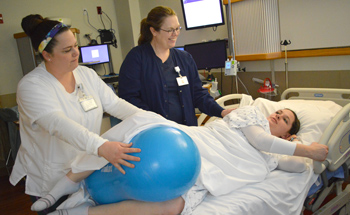How the Peanut Ball Improves Maternity Care

Peanut balls. It may be a funny name, but the purpose of this peanut-shaped ball is no laughing matter. In fact, this silly-sounding device is a low-risk, evidence-based method to increase a mother’s ability to cope with labor pain. This method has been shown to decrease labor times and even lower C-section rates. Beebe Women’s Health team recently purchased and instituted the use of peanut balls – oblong, peanut-shaped pillows made from the same material as the round exercise balls that have gained popularity in recent years.
However, instead of sitting on the round balls during labor, which many women do (also a great way to cope with labor pain and help labor progress), the peanut balls are for women who are laboring in bed. Often the peanut ball is used by women who have epidural anesthesia, or are otherwise unable to get up and move around. The peanut ball is not made to be sat upon; rather, it is designed to be used in bed, allowing women to use a variety of different positions all designed to open the pelvis and help bring the baby down-- and out!
Additionally, maintaining an open pelvis in labor can help eliminate painful back labor caused by a baby that is in an unfavorable position for delivery by helping the baby to turn to a more effective position.
As many women know, labor can be painful! However, one of the most effective ways of coping with labor pain is to maintain an upright position, and to keep moving! Using either the round ball or the peanut labor ball encourages women to change their position frequently, and both have been shown to help women have better birth experiences. Additionally, the peanut ball can be used for women who want or need to rest during labor, since it can be in placed safely while the woman reclines.
There is a growing body of scientific evidence to support the use of the peanut ball in labor. In one study of 201 laboring women, the women who used a peanut ball experienced a shorter first stage of labor (prior to pushing) by 29 minutes and a shorter pushing stage by 11 minutes. Other studies have shown even greater benefits – up to 90 minutes in the first stage and 22 minutes in pushing. Women using the peanut ball were less than half as likely to undergo a C-section. (Source: Tussey and Botsios, “Decrease the length of labor with the use of a labor ball with patients that receive an epidural” (2011).)
The peanut ball can be used between the legs or as a prop for the upper torso when a woman is more comfortable on all fours. There are many different positions and it is best for a woman in labor to change positions regularly to get the best use of the ball. Beebe Healthcare has reference cards for different positions in every labor room and all of the labor nurses are skilled in the use of both types of labor balls.
Beebe Women’s Health is taking many steps to improve the Labor & Delivery unit for mothers and their babies and is committed to helping women have more positive birth experiences. Using peanut balls is just one way the staff of Labor and Delivery hopes will help women by shortening labor, improving comfort and pain control, reduce C-sections and ultimately, ensure a healthy mom and healthy baby at the end of every labor.
Have questions about Women’s Health at Beebe? Carrie Snyder, MSN, APRN, FNP-BC, Women’s Health Nurse Navigator, is available to answer your questions. Call Carrie at (844) 316-3330 or email [email protected].
Beebe is celebrating a “Month of Mothers” throughout May. Join the discussion on our blog and find resources, information, and stories about motherhood on our Women’s Health microsite at www.beebehealthcare.org/be-there. Follow along on Beebe Healthcare’s Facebook page and follow BeebeWomensHealth on Instagram.

Rebecca Njord, MSc, MSN, WHNP-BC, CNM, is dually-licensed as a Women's Health Nurse Practitioner and Certified Nurse Midwife. Rebecca is passionate about women's healthcare including primary care, pregnancy, menopause, and beyond. She provides full-scope midwifery care which includes both obstetrics and gynecology. As a midwife, Rebecca is proud to offer women's healthcare that is patient-centered, evidence-based and comprehensive. Rebecca completed her initial nursing education at Duke University and her advanced-practice training at the University of Pennsylvania. Prior to becoming a Midwife and Nurse Practitioner, Rebecca worked in public health for many years and holds a Master's in Infectious Disease Epidemiology from the London School of Hygiene and Tropical Medicine.
